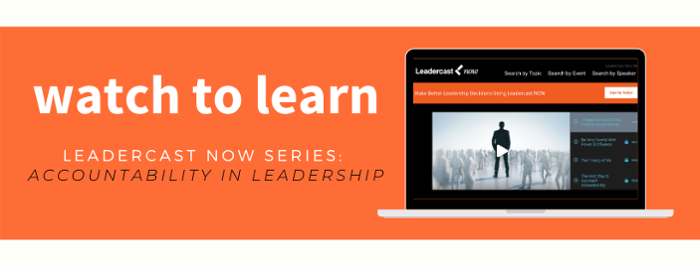Accountability—that expectation to justify your actions and bear any consequences—often elicits a negative, reactive feeling. But accountability also can be a positive, proactive part of your work culture that energizes and motivates workers to achieve their goals.
A proactive culture of accountability coordinates workers; it infuses everyday behaviors toward common goals. Importantly, it does so in a way that becomes automatic so that accountability is expected and second-nature.
A culture of accountability infuses the work environment with a sense of ownership and pride that is self-perpetuating.
So how can you create a culture of accountability and better achieve your organization’s goals? Here are five science-backed steps, starting with the big picture and getting to the nitty-gritty, day-to-day implementation.
Featured Resource: Accountability in Leadership
1. Make accountability a value (not a threat).
Accountability should be part of your company’s mission statement. Highlight it during the hiring process, repeat it at meetings, and casually thank employees in the break room for taking ownership and responsibility for their work. A values-based orientation (compared to a compliance- or rule-based orientation) increases employee willingness to report bad behavior, and they will work harder on what they know is valued. Increasing the value of accountability tips behavior toward more productive day-to-day actions. Additionally, when people value accountable behavior, it can become an important part of their self-identity and personal morals. People are naturally motivated to behave in a way that aligns with their identity.
2. Model accountability and set norms. As a leader, people look to you to learn how to behave. Walking the walk, so to speak, not only shows workers that you value accountability, but it shows them how. Your behavior sets norms—the unwritten rules that set expectations for how people are expected to behave. The norms you set can permeate the workplace and encourage people to act more accountable as a result.
3. Break up goals into subgoals. SMART goals—goals that are specific, measurable, attainable, relevant and timed—can help in achieving big, long-term aspirations. When large goals are divided into clear, smaller and incrementally measured objectives, people are more likely to stay motivated. The goals appear reachable, the reward is near and performance improves.
4. Design in advance. Design plans and delegate resources in advance to support achieving goals. Preset plans help employees avoid distractions and conflict before they arise, and they guide behavior during uncertainty. For instance, these designs might include:
- Ensuring employees have the resources and power needed to take ownership of their goals. For example: Do your employees feel comfortable calling meetings on their own or seeking outside assistance? Do they have the materials and access needed to achieve their goals?
- Creating implementation intentions. These if-then action plans clarify exactly what behavior to do at exactly what times. These plans can be useful for relatively large decisions (e.g., “If we have not sold at least 500 units in person by June, then we will switch our sales strategy and shift resources online”), but are especially helpful for small daily decisions (e.g., “If I am distracted by social media, then I will stand up and stretch for two minutes”).
- Meeting regularly with employees. Listen to feedback and update plans as needed.
5. Assist employee well-being. A bit of anxiety can be a helpful motivator, and occasionally feeling down might actually lead to more realistic judgments, but chronic or intense anxiety, depression and frustration can lead to burnout, which can, in turn, lead to bad behavior and poor performance. Over 40 percent of employees may experience burnout and goal disengagement at some point. Boosting employee well-being provides them the mental reserves needed to stay focused and avoid nonproductive behavior. To boost employee well-being, consider:
- Providing work schedule flexibility and telecommuting options. Seventy percent or more of employees consider such flexibility valuable.
- Making work environments more comfortable and less fatiguing. This could come in the form of ergonomic chairs, climate control or garden areas.
- Encouraging participation in ongoing well-being programs and activities, such as employee yoga, Headspace or PsychologyCompass.
- Getting creative. Perhaps mandate break times where employees must step away from their desks and are encouraged to walk for 15 minutes. Or encourage the entire office to write a thank-you note to one of their colleagues once a month.
6. Hold others accountable swiftly and consistently. This final step circles back to the first: by taking action to punish and reward as a result of people’s behaviors or performance, you demonstrate that you truly value accountability. Rewards and punishments should be swift and consistent. This means that failures should be addressed quickly before they escalate into patterns or norms. Often this involves simply identifying and clarifying what went wrong, expressing disapproval and then working together to fix it. Rewards, on the other hand, rarely need to be big. Promotion or financial benefits may be appropriate, but nonmonetary rewards can be very effective, too. Consider acknowledging your team’s reliability at your next meeting or simply saying, “Thank you for [your accountable behavior],” at the water cooler.
What are you doing to create a culture of accountability in your organization? Tell us on Twitter at @Leadercast.





